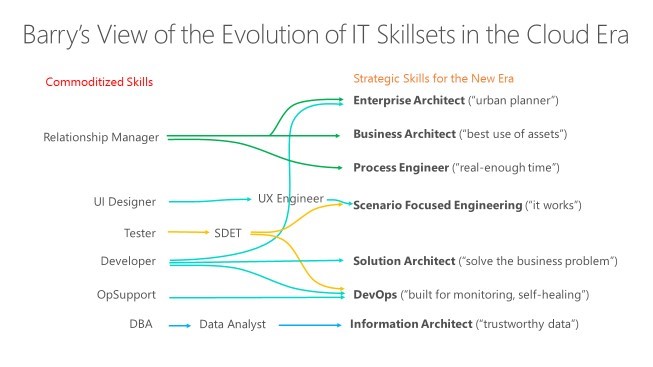Evolution of IT Roles in a Cloud World
Hello everyone, welcome back from the summer; here in the Pacific Northwest I can attest it was very sunny and surprisingly hot!
One of the topics that frequently comes up in briefings and in discussions with customers is the evolution of roles in enterprise IT as we enter the cloud era. Historically, IT departments have organized in the following way: relationship managers (often called account managers or solution delivery managers) connect with their business counterparts and help translate business goals into technical deliverables, with the most prominent artifact typically being a requirements document for a given application or application ecosystem (my frequently used term for a group of cooperating applications that create an overall business solution). As many of you know, creating a clear, lucid, actionable requirements document is actually quite a high art, and those that can do it are, and should be, highly valued.
Implementing the requirements documents are technical teams, using comprising developers, testers, UI specialists, and database analysts.These are the people that create the applications, usually following an SDLC of one sort or another (which could be more or less waterfall, agile, and so on).
Once the application has completed unit, feature, and user acceptance testing it is deployed and (again we are talking traditional environments) it becomes the responsibility of an operations staff to keep it running, ensure it is backed up, provide the right set of hardware network resources to meet its SLA, and so on and so on.
There are a lot of handoffs here, as you can see, and these introduce unwanted latency into IT.
It's now mostly incontrovertible that the cloud changes IT roles. My experience is that there are two fundamental, and equally essential strategies managers must address in this new world: that for migrating existing applications to the cloud, and second, for becoming cloud-native. Both of these require building new (or strengthening existing) muscles. Why? Because above all, using the cloud means you can run your business much, much faster and more efficiently. And that means your teams must be able to run at cloud speed!
First of all, in my view, the cloud era reinforces the need for the architect function. It’s critical that technical investments provide maximum business value, and architects, who understand both business process and technology, are uniquely suited to provide leadership and guidance on how to best exploit the advantages the cloud provides for their businesses.Enterprise architects optimize ecosystems of technologies to meet business needs; business architects (to some degree superceding relationship managers) connect business to application functionalities; information architects manage that most precious of enterprise assets, data, using canonical models and techniques like Big Data and machine learning to extract new insights.
Second, the user experience takes on new importance the simplicity – indeed, the enjoyment – of an application is very much tied to its usage and success. In the old days it was about reducing the number of gestures to accomplish a task; while that’s still important, now the field of scenario engineering looks to make an entire workflow end to end as seamless and as straightforward as possible whether it be for one user or a group of people collaborating.
And, third, the most obvious evolution in some ways is represented in the term “DevOps” which brings together the previously siloed functions of development, test and operations in an agile way. This very healthy consolidation of skillsets into project teams means a far healthier collaboration between previously separated and isolated teams. The successful deployment and operation of a service (no longer limited to a single application) becomes now a shared responsibility and accountability between developer (who builds in the right kinds of monitoring and self-healing, in addition to business logic), and operations (who among other things creates automated scripts to use the new tooling and provide the right sorts of responses) – with counsel and often leadership from architects. DevOps, history will show, makes IT overall far more responsive. (Check out the excellent DevOps blog and Volker Will’s great Technet blog!)
The objective, of course, is to massively streamline the business idea-to-deployment cycle. By eliminating the siloes and by creating agile, collaborative teams combining areas of expertise and by taking advantage of the on-demand capabilities of the cloud: you can do this!
I’ve put together a slide (above) on the evolution of IT skills and have shown it in a number of customer briefings and group presentations here at Microsoft. It’s just one point of view, however, and I’d be very interested in your comments.
Best to all,
Barry
